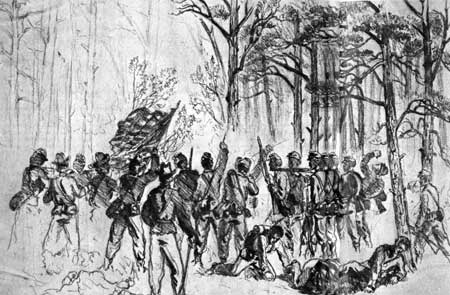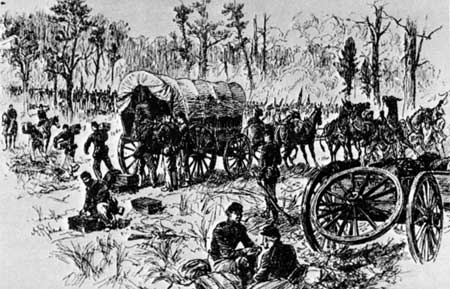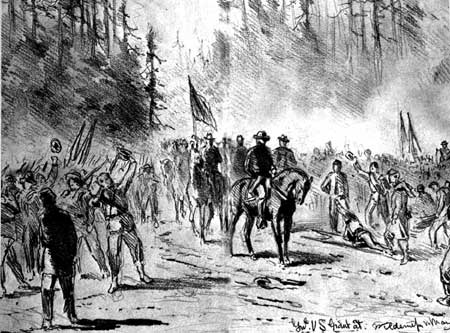|
FREDERICKSBURG and SPOTSYLVANIA COUNTY BATTLEFIELDS MEMORIAL National Military Park |
 |

Fighting near the junction of the Orange Plank and
Brock Roads, a line of Winfield Hancock's VI corps looses a volley in
the sketch by Edwin Forbes.
Courtesy, Library of
Congress.
THE FLAMING WILDERNESS
During the day fighting raged furiously all along the line, from south of the Orange Plank Road to north of the turnpike—fighting such as these two armies had never seen before and would never see again. Troops could not maneuver in the wild country, battlelines broke into tiny fragments, nobody could set anything at all. Line officers guessed at the progress of the battle by the sound of the musketry. Regiments, brigades, and even divisions became inextricably mixed. Yet, in fighting as vicious as any in the whole war, neither side gave an inch. Here and there the dry underbrush caught fire, adding to the horror and confusion, and many of the wounded burned to death in the flaming Wilderness.
In the hot, still air the thick smoke clung to the ground before lifting, and through it muskets flashed and crackled as men fired blindly. The noise roared to a crescendo that left them dazed. Regimental and company commanders lost communication and control in the dense forest, amid the underbrush, swamps, creeks smoke, flames, and noise. In some places even companies had to advance or retreat in single file, never knowing who or what was on their left or right.
As the sunset faded, darkness finally settled like a gently restraining hand over the horror and confusion on the field. Motionless forms covered the ground in grotesque positions, as if carelessly heaved there. That night, in the flickering light of candles and lanterns, stretcher bearers worked to carry in the wounded and dying.

A supply wagon brings ammunition to troops of
Gouverneur Warren's V corps in the Wilderness.
Courtesy, Library
of Congress.
The next morning it began all over again. Hancock had reached the Brock Road late the previous afternoon, just in time to save Getty's division from being driven off by A. P. Hill, and now was firmly entrenched along it. When Burnside's IX Corps came up, Grant used it to try to fill the gap between Hancock's right and Warren's left. The entire army was now committed to action, and Grant ordered Hancock to drive Hill back and roll up Lee's right flank before Longstreet's corps could arrive. Sedgwick and Warren were to keep pressure on Ewell to prevent Lee from shifting forces from left to right to help Hill.
Hill's men had fought all the previous day and were trying to straighten out their lines that morning when Hancock's relatively fresh troops hit them and drove them west along the Orange Plank Road. About 2 miles west of the crossroads was a meager little clearing in the woods around the Widow Tapp farm. Here stood Lee himself among some parked guns trying to rally the men. Another mile west and the Federals would be around his right flank and among his supply trains, and the whole Army of Northern Virginia would be in grave danger.

As the ranks cheer, Grant pushes through
to the head of his columns on the night of May 7, 1864, heading south
and leading his men on to more fighting.
But as Hancock's men emerged from the woods into the Tapp clearing, the massed Confederate cannon blasted them back. Before they could regroup for another advance, Longstreet's troops appeared dramatically on the field at the most crucial moment of the battle for Lee. The furious fighting continued all day, but Longstreet had stopped Hancock's advance. By swinging south of the Plank Road he had overlapped the Federal left, and forced Hancock to withdraw behind his works along the Brock Road. Confederate attempts to capture these works failed, and, in the process of reconnoitering, Longstreet was wounded. Gen. A. H. Anderson then assumed command of the corps.
As night came on, it was evident to both Lee and Grant that the two armies were now entrenched so strongly that attack by either side could be suicidal. The struggle in the Wilderness was over. The Federals lost 15,387 out of 118,000 in killed, wounded, and missing; the Confederates 11,400 out of 62,000.

|
|
Last Modified: Mon, Dec 2 2002 10:00:00 am PDT |


